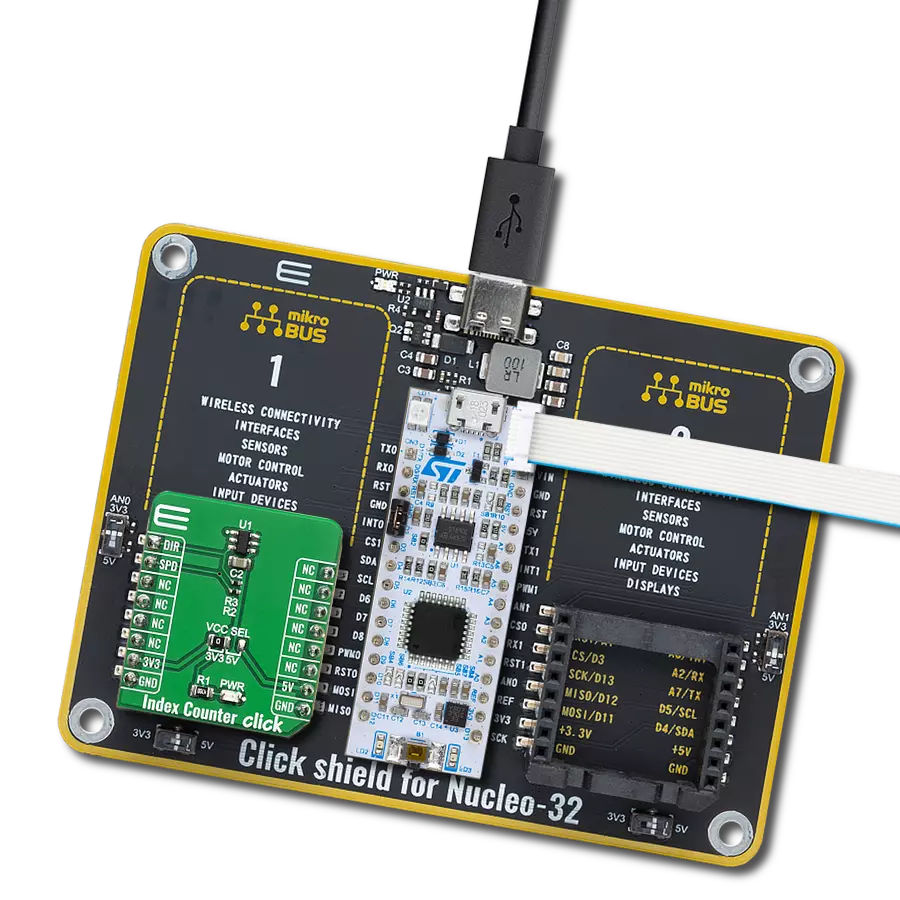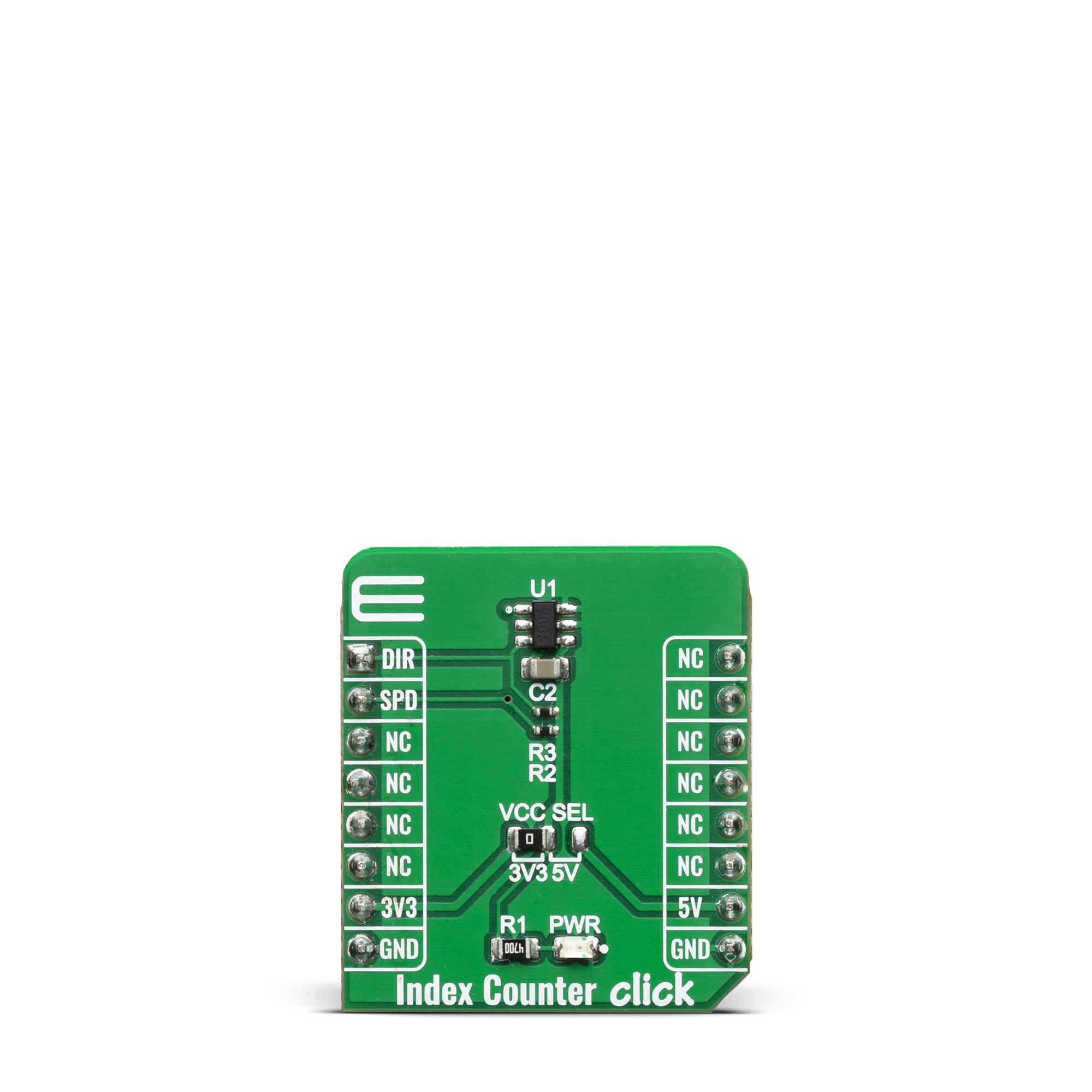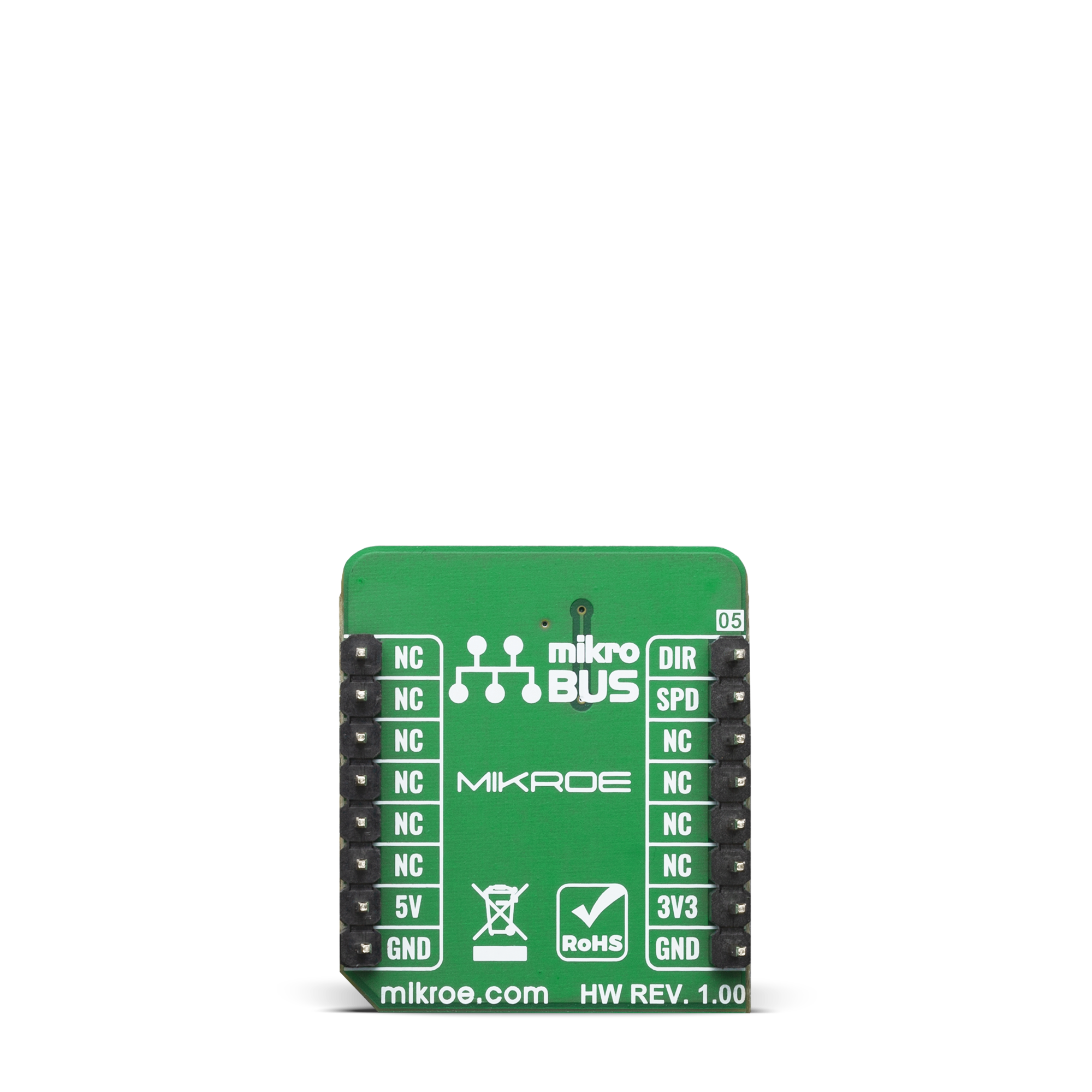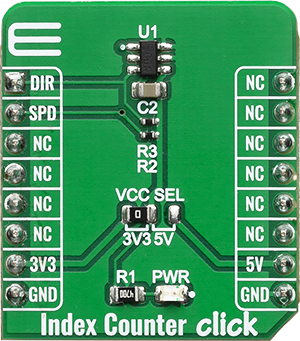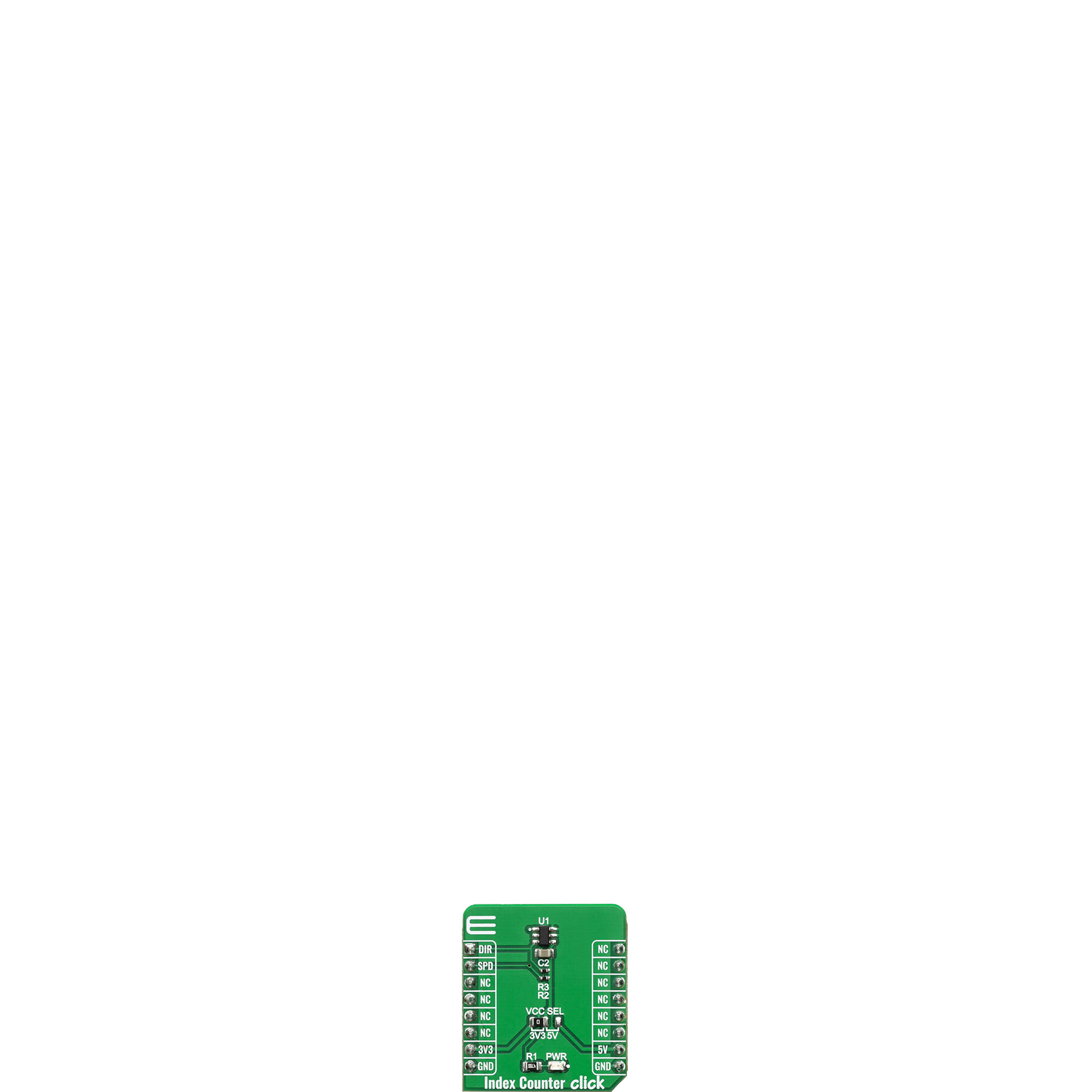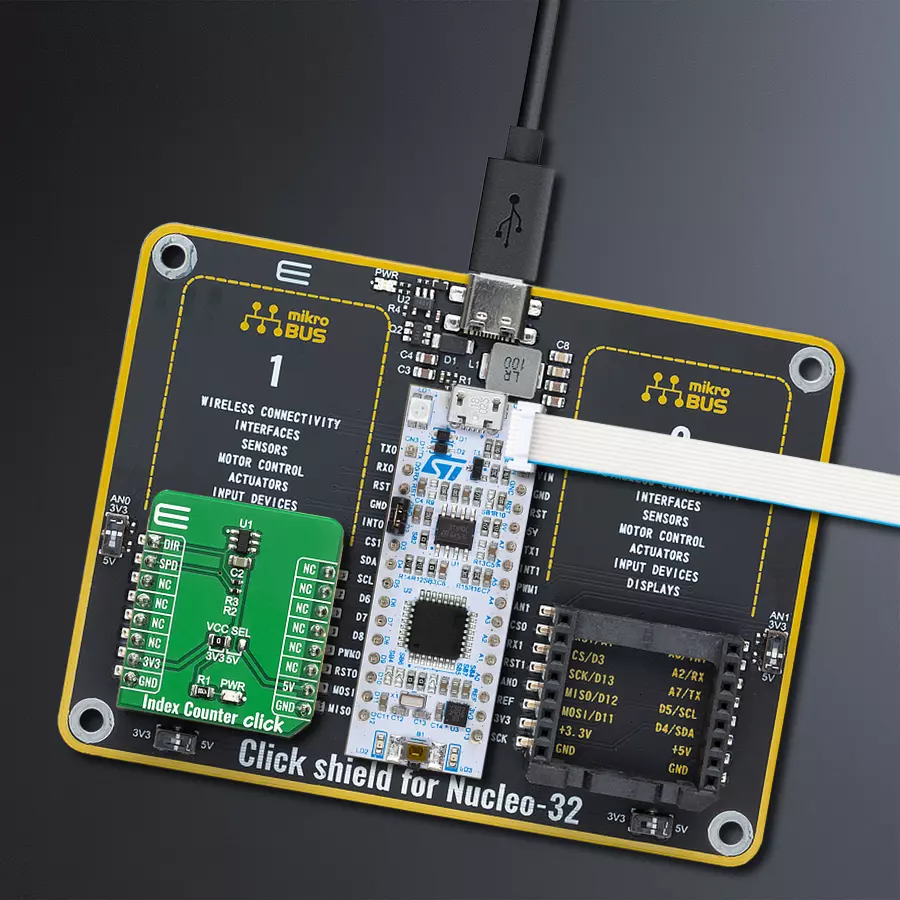Unleash your creativity and develop groundbreaking solutions with a high-precision Hall-Effect switch that offers directional sensing capabilities
A
A
Hardware Overview
How does it work?
Index Counter Click is based around the TLE4966K, which is a high sensitivity and high stability of the magnetic switching points sensor with reverse battery protection from Infineon. This sensor has many features that make it a perfect solution for small designs such as the Index Counter Click board™. One of these features is certainly its high level of integration that allows a minimal number of external components. The TLE4966K provides excellent temperature compensation capability for keeping the output stable under changing temperature. It is designed specifically for highly accurate applications with a speed signal for every magnetic pole pair, as well as direction
information. The TLE4966 Hall Sensors feature two integrated and calibrated sensor elements for detecting direction and counting indexes. This feature eliminates the need for a second sensor and cuts engineering and production costs. Using just one sensor also raises system quality and reliability. The chopped Double Hall Switch comprises two Hall probes, bias generator, compensation circuits, oscillator, and output transistors. The bias generator provides currents for the Hall probes and the active circuits. Compensation circuits stabilize the temperature behavior and reduce technology variations. The Active Error Compensation rejects offsets in signal
stages and the influence of mechanical stress to the Hall probes caused by molding and soldering processes and other thermal stresses in the package. This chopper technique together with the threshold generator and the comparator ensures high accurate magnetic switching points. This Click board™ can operate with either 3.3V or 5V logic voltage levels selected via the VCC SEL jumper. This way, both 3.3V and 5V capable MCUs can use the communication lines properly. Also, this Click board™ comes equipped with a library containing easy-to-use functions and an example code that can be used as a reference for further development.
Features overview
Development board
Nucleo 32 with STM32F031K6 MCU board provides an affordable and flexible platform for experimenting with STM32 microcontrollers in 32-pin packages. Featuring Arduino™ Nano connectivity, it allows easy expansion with specialized shields, while being mbed-enabled for seamless integration with online resources. The
board includes an on-board ST-LINK/V2-1 debugger/programmer, supporting USB reenumeration with three interfaces: Virtual Com port, mass storage, and debug port. It offers a flexible power supply through either USB VBUS or an external source. Additionally, it includes three LEDs (LD1 for USB communication, LD2 for power,
and LD3 as a user LED) and a reset push button. The STM32 Nucleo-32 board is supported by various Integrated Development Environments (IDEs) such as IAR™, Keil®, and GCC-based IDEs like AC6 SW4STM32, making it a versatile tool for developers.
Microcontroller Overview
MCU Card / MCU

Architecture
ARM Cortex-M0
MCU Memory (KB)
32
Silicon Vendor
STMicroelectronics
Pin count
32
RAM (Bytes)
4096
You complete me!
Accessories
Click Shield for Nucleo-32 is the perfect way to expand your development board's functionalities with STM32 Nucleo-32 pinout. The Click Shield for Nucleo-32 provides two mikroBUS™ sockets to add any functionality from our ever-growing range of Click boards™. We are fully stocked with everything, from sensors and WiFi transceivers to motor control and audio amplifiers. The Click Shield for Nucleo-32 is compatible with the STM32 Nucleo-32 board, providing an affordable and flexible way for users to try out new ideas and quickly create prototypes with any STM32 microcontrollers, choosing from the various combinations of performance, power consumption, and features. The STM32 Nucleo-32 boards do not require any separate probe as they integrate the ST-LINK/V2-1 debugger/programmer and come with the STM32 comprehensive software HAL library and various packaged software examples. This development platform provides users with an effortless and common way to combine the STM32 Nucleo-32 footprint compatible board with their favorite Click boards™ in their upcoming projects.
Used MCU Pins
mikroBUS™ mapper
Take a closer look
Click board™ Schematic

Step by step
Project assembly
Track your results in real time
Application Output
1. Application Output - In Debug mode, the 'Application Output' window enables real-time data monitoring, offering direct insight into execution results. Ensure proper data display by configuring the environment correctly using the provided tutorial.

2. UART Terminal - Use the UART Terminal to monitor data transmission via a USB to UART converter, allowing direct communication between the Click board™ and your development system. Configure the baud rate and other serial settings according to your project's requirements to ensure proper functionality. For step-by-step setup instructions, refer to the provided tutorial.

3. Plot Output - The Plot feature offers a powerful way to visualize real-time sensor data, enabling trend analysis, debugging, and comparison of multiple data points. To set it up correctly, follow the provided tutorial, which includes a step-by-step example of using the Plot feature to display Click board™ readings. To use the Plot feature in your code, use the function: plot(*insert_graph_name*, variable_name);. This is a general format, and it is up to the user to replace 'insert_graph_name' with the actual graph name and 'variable_name' with the parameter to be displayed.

Software Support
Library Description
This library contains API for Index Counter Click driver.
Key functions:
indexcounter_get_dir- This function returns a state of the direction DIR ( AN ) pinindexcounter_get_speed- This function returns a state of the speed SPD ( RST ) pin.
Open Source
Code example
The complete application code and a ready-to-use project are available through the NECTO Studio Package Manager for direct installation in the NECTO Studio. The application code can also be found on the MIKROE GitHub account.
/*!
* \file
* \brief Index Counter Click example
*
* # Description
* This application enables usage of Index counter Click board which can be used to measure rotational speed.
*
*
* The demo application is composed of two sections :
*
* ## Application Init
* Initilaziation of GPIO and write log.
*
* ## Application Task
* This is an example which demonstrates the use of the Index Counter Click board.
* This example shows the direction of movement, Rotations Per Minute ( RPM or speed )
* of the three pairs of rotating poles positioned in the sensor operating range.
* Results are being sent to the Usart Terminal where you can track their changes.
*
* *note:*
* Additional Functions :
* - void log_display ( float rpm_val ) - The function displays all results
* and a float value with a comma with two decimal places.
*
* \author MikroE Team
*
*/
// ------------------------------------------------------------------- INCLUDES
#include "board.h"
#include "log.h"
#include "indexcounter.h"
// ------------------------------------------------------------------ VARIABLES
static indexcounter_t indexcounter;
static log_t logger;
uint8_t dir_state;
uint8_t speed_state;
uint8_t enable_speed = INDEXCOUNTER_SPEED_ENABLE;
uint8_t n_pole_pairs = 3;
uint32_t time_cnt = 0;
uint32_t pulse_ms;
uint32_t start_timer = 1;
float speed_rpm;
// ------------------------------------------------------- ADDITIONAL FUNCTIONS
void log_display ( float rpm_val )
{
uint16_t disp_float;
disp_float = ( uint16_t ) rpm_val;
log_printf( &logger, " Direction :" );
if ( dir_state == 0 )
{
log_printf( &logger, " Forward \r\n" );
}
else
{
log_printf( &logger, " Reverse \r\n" );
}
log_printf( &logger, " Speed : %d.", disp_float );
disp_float = ( uint16_t ) ( rpm_val * 100 );
log_printf( &logger, "%d rpm\r\n", disp_float );
log_printf( &logger, " Time : %ld ms \r\n", time_cnt );
log_printf ( &logger, "-----------------------" );
}
// ------------------------------------------------------ APPLICATION FUNCTIONS
void application_init ( void )
{
log_cfg_t log_cfg;
indexcounter_cfg_t cfg;
/**
* Logger initialization.
* Default baud rate: 115200
* Default log level: LOG_LEVEL_DEBUG
* @note If USB_UART_RX and USB_UART_TX
* are defined as HAL_PIN_NC, you will
* need to define them manually for log to work.
* See @b LOG_MAP_USB_UART macro definition for detailed explanation.
*/
LOG_MAP_USB_UART( log_cfg );
log_init( &logger, &log_cfg );
log_info(&logger, "---- Application Init ----");
// Click initialization.
indexcounter_cfg_setup( &cfg );
INDEXCOUNTER_MAP_MIKROBUS( cfg, MIKROBUS_1 );
indexcounter_init( &indexcounter, &cfg );
}
void application_task ( void )
{
// Task implementation.
speed_state = indexcounter_get_speed( &indexcounter );
dir_state = indexcounter_get_dir( &indexcounter );
if ( enable_speed && speed_state )
{
pulse_ms = time_cnt - start_timer;
start_timer = time_cnt;
speed_rpm = INDEXCOUNTER_ONE_MIN_CONV_MS / ( pulse_ms * n_pole_pairs );
enable_speed = INDEXCOUNTER_SPEED_DISABLE;
log_display ( speed_rpm );
}
if ( ( !enable_speed ) && ( !speed_state ) )
{
enable_speed = INDEXCOUNTER_SPEED_ENABLE;
}
Delay_1ms();
time_cnt++;
}
int main ( void )
{
/* Do not remove this line or clock might not be set correctly. */
#ifdef PREINIT_SUPPORTED
preinit();
#endif
application_init( );
for ( ; ; )
{
application_task( );
}
return 0;
}
// ------------------------------------------------------------------------ END
